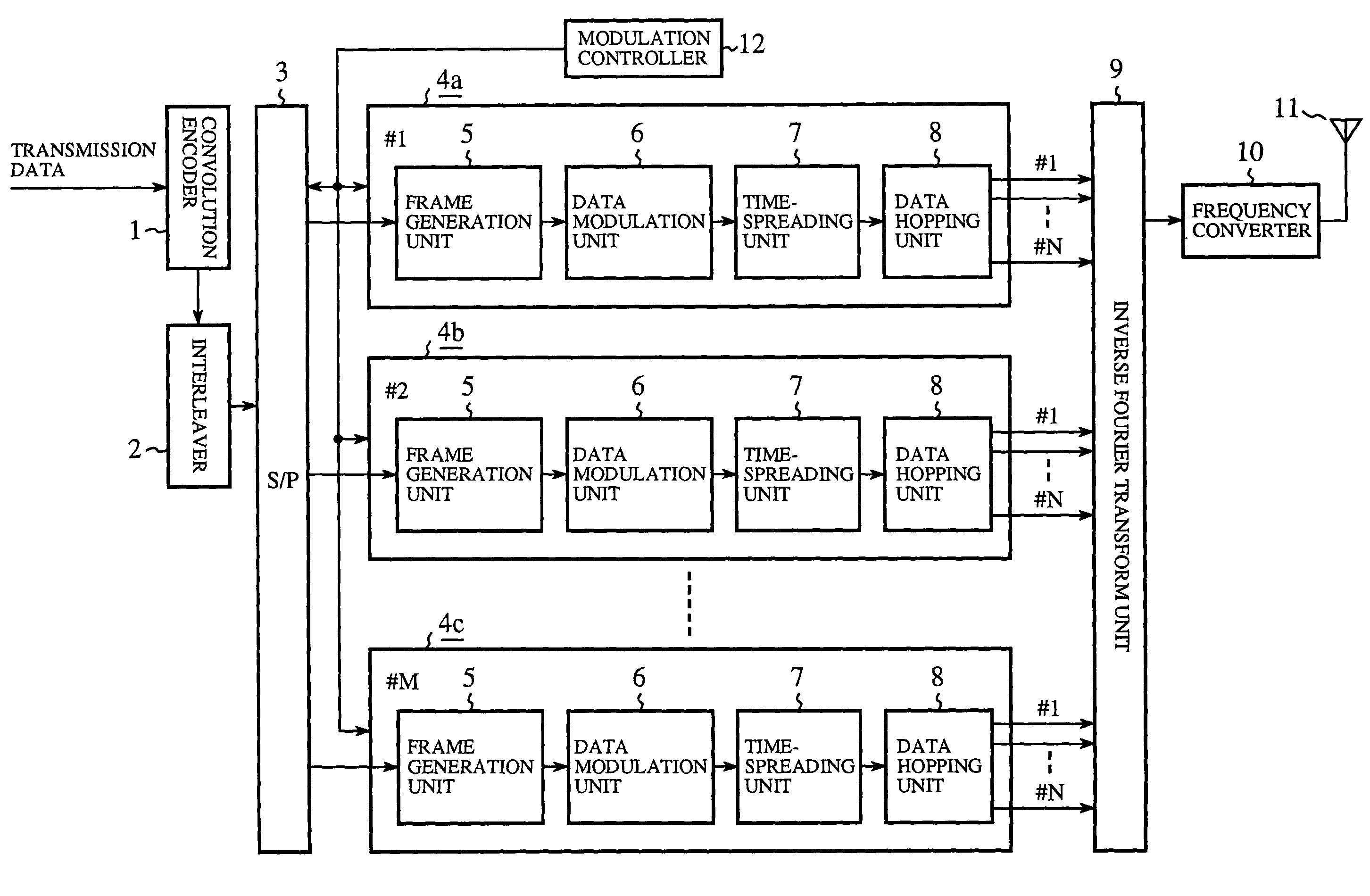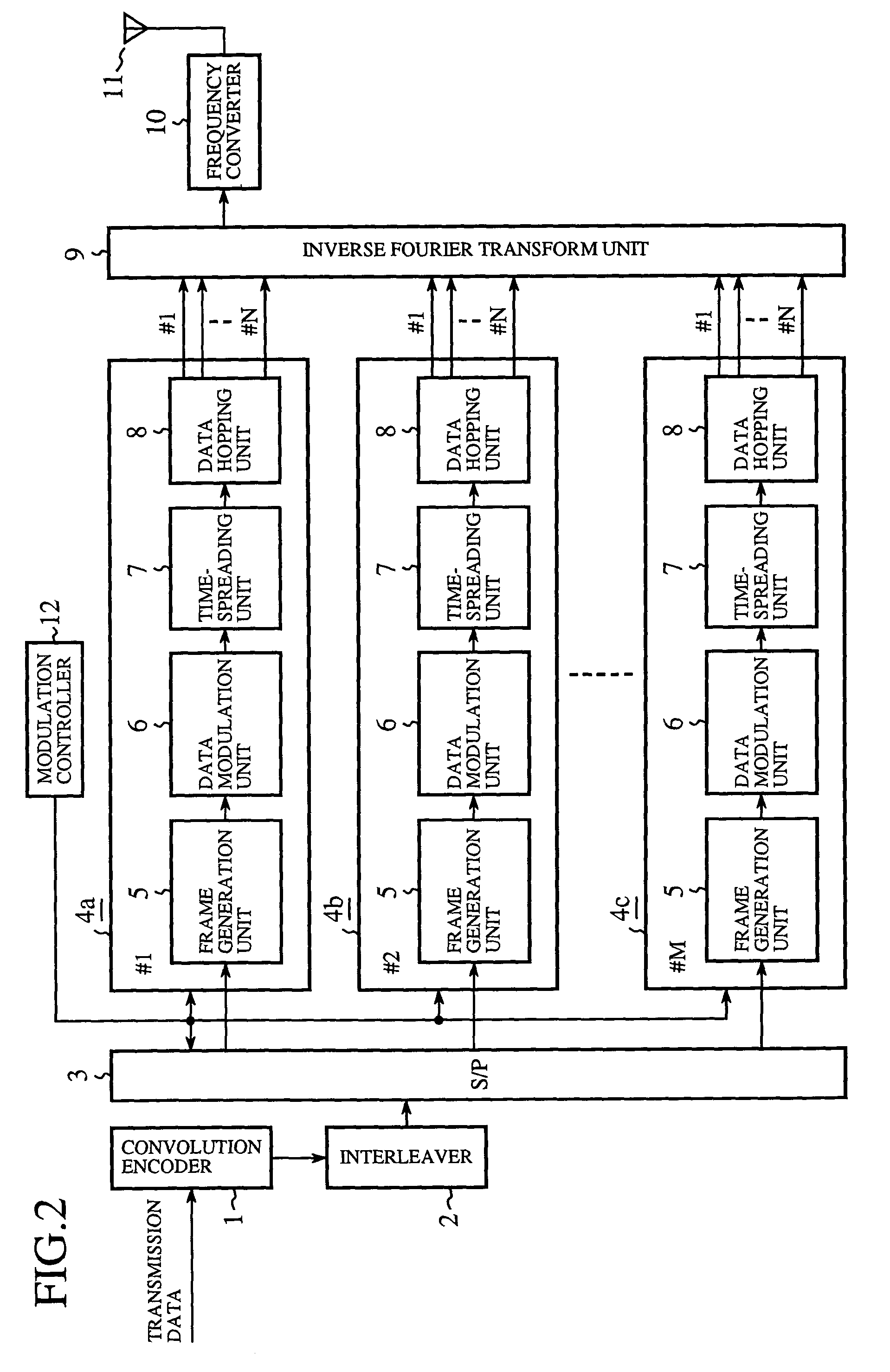Transmitter and receiver for spread-spectrum communication system, and modulation and demodulation methods thereof
a technology of spread-spectrum communication and transmitter, which is applied in the direction of multi-frequency code system, multiplex communication, orthogonal multiplex, etc., can solve the problems of low data transmission rate, unstable oscillating signal output of frequency synthesizer, and associated reduction of frequency switching wait time in frequency synthesizer, etc., to achieve the effect of improving communication quality through frequency hopping, reducing data transmission rate and poor communication quality
- Summary
- Abstract
- Description
- Claims
- Application Information
AI Technical Summary
Benefits of technology
Problems solved by technology
Method used
Image
Examples
first embodiment
[0068]FIG. 2 is a block diagram showing a construction of a transmitter for a spread-spectrum communication system according to the first embodiment. Referring to FIG. 2, the system comprises a convolution encoder 1 for subjecting input transmission data to error-correction encoding, an interleaver 2 for interleaving the encoded transmission data and a serial-to-parallel conversion unit (hereinafter, referred to as S / P) splitting the interleaved transmission data and outputting the split data for transmission using a plurality of subchannels.
[0069]The system further comprises subchannel modulation processing units 4a, 4b and 4c for modulating the transmission data of the plurality of subchannels independently. Although the transmitter shown in FIG. 2 only shows the subchannel modulation processing units 4a, 4b and 4c, the system actually comprises a sufficient number of subchannel modulation processing units 4a, 4b, . . . 4c capable of parallel processing of the transmission data in...
second embodiment
[0121]In the receiver for a spread-spectrum communication system according to the second embodiment, each subchannel demodulation processing unit examines time-despread subchannel reception data to estimate a power of interference occurring in a transmission channel. By normalizing the subchannel reception data with the interference power before outputting the data for further processes, a favorable quality of communication is ensured even when the level of interference differs from subchannel to subchannel. The receiver according to the second embodiment only differs from the receiver according the first embodiment in that the interference power is estimated so that the subchannel reception data is normalized accordingly. The other aspects of the construction remains the same so that the description thereof is omitted by denoting the corresponding elements by the same reference numerals.
[0122]The transmitter used in the spread-spectrum communication system according to the second e...
third embodiment
[0133]In the first embodiment, the bit error performance is improved by processing the data for transmission using both frequency-hopping and time-spreading spectrum spreading using inverse Fourier transform. In the spread-spectrum communication system according to the third embodiment, the data is first subjected to frequency-hopping spectrum spreading using inverse Fourier transform in each subchannel. Subsequently, a guard interval is inserted to eliminate adverse effects from delay wave occurring in the transmission channel so that the bit error performance is improved.
[0134]The description that follows highlights the transmitter and the receiver of the spread-spectrum communication system according to the third embodiment. The transmitter and the receiver according to the third embodiment only differ from the transmitter and the receiver according to the first embodiment in the construction of the subchannel modulation processing units and the subchannel demodulation processing...
PUM
 Login to View More
Login to View More Abstract
Description
Claims
Application Information
 Login to View More
Login to View More - R&D
- Intellectual Property
- Life Sciences
- Materials
- Tech Scout
- Unparalleled Data Quality
- Higher Quality Content
- 60% Fewer Hallucinations
Browse by: Latest US Patents, China's latest patents, Technical Efficacy Thesaurus, Application Domain, Technology Topic, Popular Technical Reports.
© 2025 PatSnap. All rights reserved.Legal|Privacy policy|Modern Slavery Act Transparency Statement|Sitemap|About US| Contact US: help@patsnap.com



